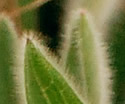Symphyotrichum sericeum (Silky Aster)
| Also known as: | Western Silver Aster |
|---|---|
| Genus: | Symphyotrichum |
| Family: | Asteraceae (Aster) |
| Life cycle: | perennial |
| Origin: | native |
| Habitat: | part shade, sun; dry sandy or rocky soil; prairies, outcrops, open woods, dunes, barrens |
| Bloom season: | August - October |
| Plant height: | 1 to 2 feet |
| Wetland Indicator Status: | none |
| MN county distribution (click map to enlarge): |  |
| National distribution (click map to enlarge): |  |
Pick an image for a larger view. See the glossary for icon descriptions.
Detailed Information
Flower: 

![[photo of flowers]](/udata/r9ndp23q/purple/silky-aster_0921_105151-t.jpg) Branching clusters of stalked flowers at the top of the stem and arising from upper leaf axils. The wiry branches are often erect or nearly so. Flowers are 1 to 1¼ inches across, 15 to 25 purple petals (ray flowers) and pale yellow center disk flowers that turn dull reddish brown with age.
Branching clusters of stalked flowers at the top of the stem and arising from upper leaf axils. The wiry branches are often erect or nearly so. Flowers are 1 to 1¼ inches across, 15 to 25 purple petals (ray flowers) and pale yellow center disk flowers that turn dull reddish brown with age.
![[photo of bracts (phyllaries)]](/udata/r9ndp23q/purple/symphyotrichum-sericeum-silky-aster_0919_183349-t.jpg) The bracts (phyllaries) surrounding the base of the flower are in 3 to 5 layers, densely covered in silky hairs, the outer phyllaries with spreading, broadly egg-shaped tips about ¼-inch long and the inner narrowly triangular to lance-linear with a sharply pointed tip. Flower stalks are up to 1¼ inch long, slender, densely covered in soft, appressed hairs, with a few to several leaf-like bracts below the flower.
The bracts (phyllaries) surrounding the base of the flower are in 3 to 5 layers, densely covered in silky hairs, the outer phyllaries with spreading, broadly egg-shaped tips about ¼-inch long and the inner narrowly triangular to lance-linear with a sharply pointed tip. Flower stalks are up to 1¼ inch long, slender, densely covered in soft, appressed hairs, with a few to several leaf-like bracts below the flower.
Leaves and stem: 


![[photo of upper stem leaves]](/udata/r9ndp23q/purple/symphyotrichum-sericeum-silky-aster_0917_173707-t.jpg) Leaves are generally oblong-elliptic, toothless, stalkless, blunt or pointed at the tip, and densely covered in long, fine hairs that give them a silky feel and silvery sheen, and is where the plant gets its common names. Leaves in the upper part of the plant are mostly ascending to erect, ½ to 1¼ inches long and up to ½ inch wide.
Leaves are generally oblong-elliptic, toothless, stalkless, blunt or pointed at the tip, and densely covered in long, fine hairs that give them a silky feel and silvery sheen, and is where the plant gets its common names. Leaves in the upper part of the plant are mostly ascending to erect, ½ to 1¼ inches long and up to ½ inch wide.
![[photo of lower leaves]](/udata/r9ndp23q/purple/silky-aster_0712_104326-t.jpg) Basal and lower stem leaves are much longer and most wither away by flowering time. Stems are single or multiple from the base, wiry and delicate, hairless near the base, densely covered in fine appressed hairs in the upper plant, and may initially be green but are typically brown.
Basal and lower stem leaves are much longer and most wither away by flowering time. Stems are single or multiple from the base, wiry and delicate, hairless near the base, densely covered in fine appressed hairs in the upper plant, and may initially be green but are typically brown.
Fruit: 
![[photo of fruit]](/udata/r9ndp23q/purple/silky-aster_1008_160624-t.jpg) Fruit is a brown seed with a tuft of light brown hair to carry it off in the wind. The seed head is ½ to ¾ inch across.
Fruit is a brown seed with a tuft of light brown hair to carry it off in the wind. The seed head is ½ to ¾ inch across.
Notes:
Silky Aster most closely resembles Aromatic Aster (Symphyotrichum oblongifolium), which has rough leaves, narrow phyllaries, and a bright yellow center disk. Silky Aster starts emerging around May; it's characterized by a clump of narrow leaves densely covered in long, soft hairs.
Native Plant Nurseries, Restoration and Landscaping Services ↓
More photos
 Silky Aster plant
Silky Aster plant Silky Aster in prairie habitat
Silky Aster in prairie habitat a patch of Silky Aster, sprawling
a patch of Silky Aster, sprawling garden-grown Silky Aster
garden-grown Silky Aster stems
stems leaves emerging in spring
leaves emerging in spring more flowers
more flowers Silky Aster pollinator
Silky Aster pollinator
Photos by K. Chayka taken at Long Lake Regional Park, Ramsey County. Photos courtesy Peter M. Dziuk taken in Otter Tail County and in a private garden in Anoka County.
Comments
Have you seen this plant in Minnesota, or have any other comments about it?
on: 2011-08-30 21:50:38
I have seen a number of Silky Asters. Old Mill State Park has large stands of Big Bluestem grass and there seem to be a lot of Silky Asters around those stands.
on: 2023-09-05 12:25:31
This plant can reliably be found at Sand Prairie WMA along the prairie restoration trails.






